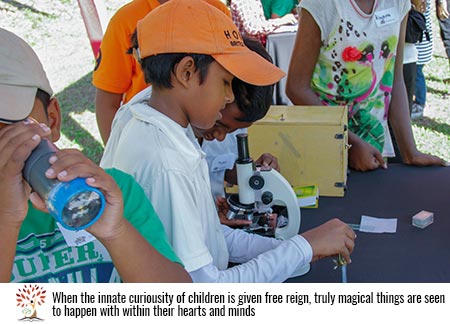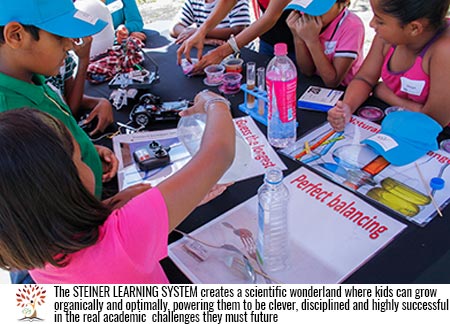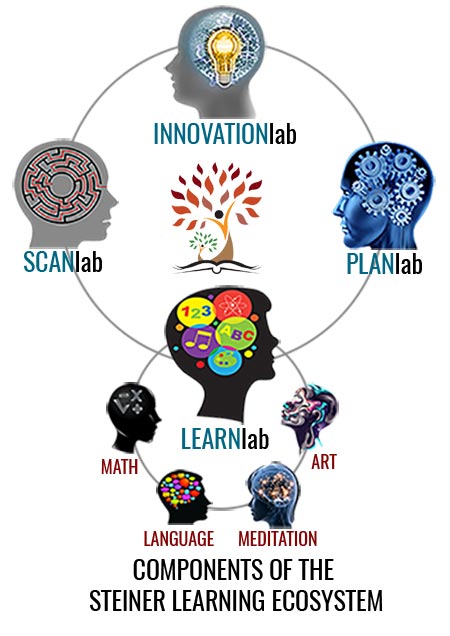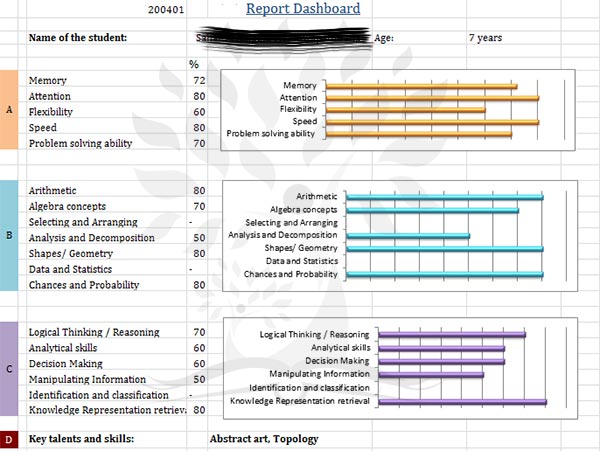|
THE FOUNDATION HABITAT
A child's brain is like a sponge, ready to soak up whatever touches it. For this reason, the ICE learning habitat surrounds children with positive, conducive, harmonious educational experiences. Replete with over 1000 custom learning aids and approximately 200 more devices and materials designed for individual children with highly specific learning requirements and impediments, the habitat is one of the best primary education units in the whole country.
A glance at the skills sets that are imparted to primary school kids at ICE reads almost like a word cloud for "education" from infancy to adulthood and should surely stop you in your tracks in utter astonishment to ask:
Seriously… Is this for real? Even if it is real, is it at all possible for kids that young to actually be taught this stuff? Even if can be taught, will my child be able to grasp all of this?
The answer to all three questions from the Steiner education engineers is yes! Yes, we have done it, yes we have proved it is possible and yes, it has been done without making kids suffer and yes, the kids themselves yearn to return again and again to this wonderland that has been created for them and yes, the system services that they acquire for use in their mainstream primary education has seen them leap, literally and figuratively, streets ahead of their peers. Most importantly, they do this with a quiet, secure, confident, compassionate and wholesome sense of accomplishment with none of the competitive, backstabbing and manipulative misery that most kids are actively trained to cultivate from a very young age as the only way to get ahead in life!
|
|
| ICE AT A GLANCE |
| Target Group: |
3 to 12 year olds (Primary School) |
| Unique Methodology: |
Screen, Analyze, Plan, Tailor, Teach |
| Subjects Covered: |
Mathematics, Science, English, Art and Innovation Skills |
| Skill Areas Covered: |
| Segment 1: Cognition and Retention: Memory, Attention, Flexibility, Speed, Problem Solving Ability, Logical Thinking / Reasoning, Decision Making, Manipulating Information, Identification and classification, Knowledge Representation Retrieval |
| Segment 2: Reasoning and Analysis: Arithmetic,selecting and arranging, analysis and decomposition ,algebra concepts, Shapes / Geometry, data and statistics, Chances And Probability |
| Segment 3: Language and Communication: Speaking, Listening, Writing, Reading, Non-Verbal Communication, Phonology, Semantics, Grammar, Pragmatics |
| Segment 4: Creativity and Self-Expression: Cognitive Creativity (New Ideas), Cognitive creativity (Modification), Aesthetic Creativity |
| Segment 5: Emotional Stability and Confidence: Team Work, Emotional Expression, Performance in Competitive Environments, Self-Motivation |
|
|
STEP 1 - RECOGNIZE DIVERSITY OF LEARNERS: The Steiner Team worked out the mechanics and processes of the ICE habitat based on two simple base premises. The first was that each child was unique in abilities, capabilities and weaknesses and no one size would ever fit all or do justice to all. The second was that during the primary growing up phase of life, the age of a child was not always directly proportional to that child’s performance.
STEP 1 - SCAN: Therefore at ICE, a team comprising of highly qualified and experienced psychologists, mathematicians, linguists, artists and educationists screens every single entrant into the program at its SCANlab using cutting-edge testing methods to determine a benchmark profile. This is the baseline of each child against which every improvement of the child is measured during the course of the program.
STEP 2 - ANALYZE AND PLAN: Next, educationists at the PLANlab analyze the information and tailor a custom program for each child to optimize improvement in the most crucial learning areas of analytics, linguistics and aesthetics.
STEP 3 - TEACH: Subsequently the LEARNlab takes over, executing the tailored plan for each child in a friendly, engaging and harmonious environment and enhances abilities in math, language and art while building self-esteem, self-confidence and self-expression.
STEP 3(1) - INNOVATE: The LEARNlab is also fed with many learning aids that are either acquired or turned out at the INNOVATIONlab. These include hundreds of skill and cognizance enhancing games, puzzles, activities, gadgets, reading material and aesthetic material. Depending on the plan for each child, these aids are deployed to optimize both the hapiness and the impact of the child's learning environment.
STEP 5 - APPLY: The child applies the knowledge acquires in various ways with constant watchfulness and guidance but very little rote regimentation simply for the sake of it.
STEP 6 - REVISIT AND REENGINEER: As the children works through the program, their individual progress is carefully monitored and recorded and fed back to the scanners, planners and innovators to design and provide the required changes to each individualized program.
|
 |
 |
|
 |
 |
|






